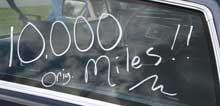I think we all understand the concept of original miles. They represent the distance a given car has been driven since its birth. The choice of the word “original” is a bit peculiar, as it implies that the car does not have replacement or replica miles, that the miles have not been transferred from another car (well, that could happen, if, for example, the speedometer and odometer had been replaced). It’s common to advertise a car’s “original miles,” however, particularly if the mileage is low, like this 1976 Cadillac seen in the 2009 Hershey Car Corral, or this ’73 Pontiac Grand Prix.
Then there are “actual miles,” which amount to the same thing, although the context suggests that they are neither figurative or fake. Actual miles were also rampant at this year’s Hershey meet, blatant in some cases. And there was even one car that had both original and actual miles.
As the miles, whether original or actual, get higher and the car less pristine, they become less important, often an afterthought on the For Sale sign, although a car with high miles can still be very desirable. Sometimes, with a very distinctive car like a De Tomaso Pantera, it’s sufficient to say simply “miles.”
There comes a time and place, however, when even “miles” is superfluous, when the number alone speaks for itself.

